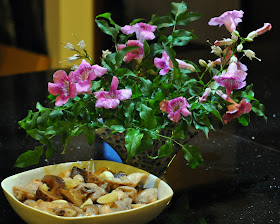These delightful lilac-pink flowers of Podranea ricasoliana aka 'Pink Trumpet Vine' bloom the whole year round. It is actually a climber but I've trained it into a slender tree of about 12 feet high.
I love its pastel colours against the light blue sky.
The rim of dark pink around the entrance to the tubular part seems to be a pointer for insects.
I've seen carpenter bees with big girths struggling to get into the deeper recesses of the flowers.
An unidentified moth*with transparent patches in its wings hangs precariously on this flower. The underlying pink of the flower shows through its wings making it look like a pink-coloured moth.
(now identified as *Clear Wing Tiger moth, Ceryx sphenodes - updated on 25.1.2016)
It is not what you look at that matters, it is what you see
~ Hendry David Thoreau
~ Hendry David Thoreau
The lateral branches arch gracefully down displaying the blooms for eye candy enjoyment at eye level.
The yellow trumpet flowers of Allamanda cathartica and Tecoma Stans (image below) provide a strong contrast of colours.


This is a tree-top view from above. The compound leaves of dark glossy green provide a nice background to the flowers which are produced terminally.
I shot this from the first floor balcony. My plants have a good drenching from this high-powered hosing. Water pressure was high but adjusted to a rose shower so as not to damage the flowers.

Fallen flowers gave the lawn an added texture of interest. I usually leave the flowers on the lawn as it is, ornamented with Nature's baubles to be enjoyed for a while longer.
This snail enjoyed gliding along the watering hose so much, it refused to get off it. It moved along the hose for
many, many feet and seemed to be enjoying itself so much that I've no
heart to interrupt its glee. I left it to its own devices for the
night. The next morning it was gone. Well ... so be it.
I shot this from the first floor balcony. My plants have a good drenching from this high-powered hosing. Water pressure was high but adjusted to a rose shower so as not to damage the flowers.
When a strong wind blows the flowers float gently down.

Fallen flowers gave the lawn an added texture of interest. I usually leave the flowers on the lawn as it is, ornamented with Nature's baubles to be enjoyed for a while longer.
“It does not matter how slowly you go as long as you do not stop.”
― Confucius
A dish of Steamed Chicken with Mushroom and Garlic
For recipe, please click on my food blog,
http://stiletto-goodeats.blogspot.com/




















































